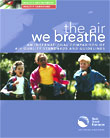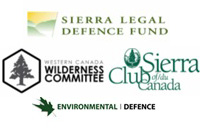
News |
- Premier Provides Trans Canada Trail $1 Million
- Kimberly-Clark Lying About Pulp Policy
- Air Quality Leaves Canadians Choked
- Elizabeth May Elected Green Party Leader
- Canada Failing Species At Risk
- BC's Tyee Features Climate Change
- World Water Week - World Water Shortages?
- Cycle for Climate Justice on Katrina Anniversary
- Half Million for East Side Lands Planning
- Wal-Mart Going Green
- Funds for Wapusk Ecological Studies
- First Nation Granted Mining Injunction
| Premier Provides Trans Canada Trail $1 Million | 05 September 06 |
 Premier Gary Doer has announced $1 million to the Manitoba Recreational Trails Association late in August and $500,000 to assist efforts to continue the construction of the Manitoba portion of the Trans Canada Trail (TCT). Premier Gary Doer has announced $1 million to the Manitoba Recreational Trails Association late in August and $500,000 to assist efforts to continue the construction of the Manitoba portion of the Trans Canada Trail (TCT). The Trans Canada Trail is a shared-use trail (walking, cycling, equestrian, skiing and snowmobiling), linking Canada's three oceans. The 18,000-kilometre trail will be the longest continuous trail in the world . The 1,300-kilometre Manitoba portion of the trail will link hundreds of communities and traverse seven eco-districts. Manitoba Wildlands Director Gaile Whelan Enns noted, "It is good to see our government supporting the natural world. However, in contrast our government has provided little funding for the future World Heritage Site on the east side of Lake Winnipeg. Action on Manitoba's commitments to establish new protected areas in our boreal forest regions has also stalled. " Although the Manitoba government announced its support for the proposed World Heritage Site in 2004, no funds to support community initiatives and planning required to move forward with the nomination have been provided. Manitoba Wildlands will be releasing its annual Manitoba protected areas audit and the 15th annual protected areas grade in fall 2006. View the August 30, 2006 Government of Manitoba press release View Manitoba Wildlands World Heritage Site page View Poplar River First Nation web site Sources: Government of Manitoba, Manitoba Wildlands |
|
| Kimberly-Clark Lying About Pulp Policy | 30 August 06 |
 Greenpeace has written to the United States Securities and Exchange Commission (SEC) asking them to look into statements by Kimberly-Clark executives regarding their wood pulp policy. The environmental group publicly revealed investigative evidence July 26, 2006 that the company uses pulp from the coastal temperate rainforests of British Columbia, despite repeated public claims to the contrary. Greenpeace has written to the United States Securities and Exchange Commission (SEC) asking them to look into statements by Kimberly-Clark executives regarding their wood pulp policy. The environmental group publicly revealed investigative evidence July 26, 2006 that the company uses pulp from the coastal temperate rainforests of British Columbia, despite repeated public claims to the contrary.The claims, which date as far back to 1998, appear in numerous company publications including the company's 2006 proxy statement, 2005 Sustainability Report, and correspondences with the SEC. The evidence is compiled in an investigative report entitled Chain of Lies: the Truth about Kimberly-Clark's Use of Ancient Rainforests for Tissue Products, and is based in part on US Customs data. The company has also been implicated in the destruction of North America's largest ancient forest, the Boreal, which is home to endangered species and essential in combating global warming. Greenpeace also announced more than 650 businesses in North America and around the world are refusing to use tissue products made by the Kimberly-Clark Corporation. The businesses were featured in an ad in the New York Times on August 22, 2006. Kimberly-Clark is the largest tissue product company in the world, manufacturing the popular Kleenex brand of tissue products. View the July 26, 2006 Greenpeace Canada press release View the Greenpeace letter requesting an investigation (PDF) View the report, Chain of Lies: the Truth about Kimberly-Clark's Use of Ancient Rainforests for Tissue Products (PDF) View the August 22, 2006 Greenpeace Canada press release Visit the Forest-Friendly 500 web site Visit Kleercut.net and view information about Kimberly-Clark's impacts in Canada's boreal forests Source: Greenpeace Canada |
|
| Air Quality Leaves Canadians Choked | 30 August 06 |
 Thousands of deaths can be prevented each year if Canada adopts the more stringent air quality standards of other industrialized countries, according to a report released August 25, 2006 by the David Suzuki Foundation. Thousands of deaths can be prevented each year if Canada adopts the more stringent air quality standards of other industrialized countries, according to a report released August 25, 2006 by the David Suzuki Foundation.The Air We Breathe compares Canada's voluntary air quality guidelines with the legally binding national standards in the United States, Europe and Australia, as well as recommendations by the World Health Organization. The report concludes with several key, workable solutions for reducing the toll of air pollution on the health and well-being of Canadians. These solutions include:
View the August 25, 2006 David Suzuki Foundation press release View the August 2006 David Suzuki Foundation report, The Air We Breathe: An International Comparison of Air Quality Standards and Guidelines (PDF) View the executive summary of The Air We Breathe: An International Comparison of Air Quality Standards and Guidelines (PDF) Source: David Suzuki Foundation |
|
| Elizabeth May Elected Green Party Leader | 28 August 06 |
 Longtime environmental activist and former Sierra Club executive director Elizabeth May decisively won the leadership of Canada's Green Party August 26, 2006. Ms. May won with 2,145 votes or 65.3 per cent of the total valid ballots cast - a two-to-one margin over environmental consultant David Chernushenko, who collected 1,096 votes or 33.3 per cent of the total. Longtime environmental activist and former Sierra Club executive director Elizabeth May decisively won the leadership of Canada's Green Party August 26, 2006. Ms. May won with 2,145 votes or 65.3 per cent of the total valid ballots cast - a two-to-one margin over environmental consultant David Chernushenko, who collected 1,096 votes or 33.3 per cent of the total.Ms. May has promised to hold policy sessions across the country and to call on experts to put together a comprehensive platform with new ideas. She also said the party would focus on the prevalence of cancer: "This country and all of North America is in the midst of a cancer epidemic that nobody wants to talk about." She also took on economic growth, comparing it with the way cancer spreads. "Unlimited economic growth is the ideology of the cancer cell." And she said the idea that Canada cannot meet its Kyoto targets to cut greenhouse gas emissions is "the big lie." At the weekend convention in Ottawa, delegates voted on almost 100 policy resolutions including Canada's role in Afghanistan, stopping subsidies for seal hunters and chemical-based farming as well as tax breaks for organic farmers. View the August 26, 2006 CBC news article View the August 26, 2006 CTV news article View the August 26, 2006 Globe & Mail article View the August 26, 2006 Macleans.ca article View the August 27, 2006, Montreal Gazette article Sources: CBC, CTV, Globe and Mail |
|
| Canada Failing Species At Risk | 24 August 06 |
 An independent evaluation has revealed rampant federal mismanagement in implementing Canada's Species at Risk Act (SARA). The evaluation by private consulting firm Stratos Inc., concludes that 'the species at risk programs and activities are not yet on track to ensure that the Act's objectives and intended outcomes will be realized.' An independent evaluation has revealed rampant federal mismanagement in implementing Canada's Species at Risk Act (SARA). The evaluation by private consulting firm Stratos Inc., concludes that 'the species at risk programs and activities are not yet on track to ensure that the Act's objectives and intended outcomes will be realized.' The evaluation was released on August 16, 2006 by Environment Canada's Audit and Evaluation Branch in response to a request from the federal Treasury Board. One key finding of the evaluation is that critical habitat was not being identified or legally protected. The number one cause of species' decline in Canada is habitat loss and the identification of critical habitat is the primary tool under SARA to enable habitat protection. The Stratos evaluation also highlights failed cooperation between the federal government and the provinces to protect Canada's endangered plants and animals. Because the Species at Risk Act doesn't automatically require protection of species on provincial lands, provincial governments are left in charge, even though many do not have laws to protect species at-risk and their habitat, or have laws on the books which they do not uphold. The failure to protect species in the provinces has led to lawsuits in British Columbia and Alberta. View the August 17, 2006 Sierra Club of Canada press release View the independent evaluation of the Canadian Governments effort to implement the Species At Risk Act Source: Sierra Club of Canada |
|
| BC's Tyee Features Climate Change | 24 August 06 |
 Independent British Columbia online journal The Tyee is featuring a five-part series on climate change. In this special series, veteran science journalist Chris Wood reports on how climate change threatens to harm British Columbia's environment, economy and way of life - and what can be done to minimize the damage. Independent British Columbia online journal The Tyee is featuring a five-part series on climate change. In this special series, veteran science journalist Chris Wood reports on how climate change threatens to harm British Columbia's environment, economy and way of life - and what can be done to minimize the damage.The recent article, Drying Up the Okanagan, explores the requirements of explosive growth and soaring water use in the Okanagan in the face of higher temperatures and rapidly vanishing snowcaps that have historically supplied water through the dry summer months. Previous articles in the series have highlighted the potential for intensified flooding on the Fraser River, and the level of (un) preparedness for such situations. View the Tyee series Rough Weather Ahead: How Global Warming Will Hit BC View the August 17, 2006 Rough Weather Ahead installment: Drying Up the Okanagan Source: The Tyee |
|
| World Water Week - World Water Shortages? | 22 August 06 |
 As we enter World Water Week, organizations around the globe are raising alarms about water scarcity. Long seen as a problem of only the poorest, water crises are increasingly affecting some of the world's wealthiest nations. As we enter World Water Week, organizations around the globe are raising alarms about water scarcity. Long seen as a problem of only the poorest, water crises are increasingly affecting some of the world's wealthiest nations.In a report released August 16, 2006, WWF International concludes that a combination of climate change and drought and loss of wetlands that store water, along with poorly thought out water infrastructure and resource mismanagement, is making the water crisis truly global. The report, Rich Countries, Poor Water, highlights impacts of water problems in countries such as Australia, Spain, Japan, and the UK, and the US. Representatives from the International Water Management Institute also warned of global water shortages at an August 16, 2006 conference. According to the IWMI, the world authority on fresh water management, one third of the world is facing water shortages because of poor management of water resources and soaring water usage, driven mainly by agriculture, which accounts for 80 percent of global water consumption. Frank Rijsberman, the institute's director-general stated that globally, water usage had increased by six times in the past 100 years and would double again by 2050. View the August 16, 2006 WWF International news item View the WWF International report Rich Countries, Poor Water (PDF) View the Guardian Unlimited Special Report on Water View the August 16, 2006 Reuters article Visit the International Water Management Institute web site Sources: WWF International, Reuters |
|
| Cycle for Climate Justice on Katrina Anniversary | 22 August 06 |
 August 25, 2006 marks the 1-year anniversary of Hurricane Katrina reaching hurricane strength. In the days that followed, the storm would strengthen rapidly over an unnaturally warm Gulf of Mexico, ultimately striking the coast and leaving thousands dead and homeless. August 25, 2006 marks the 1-year anniversary of Hurricane Katrina reaching hurricane strength. In the days that followed, the storm would strengthen rapidly over an unnaturally warm Gulf of Mexico, ultimately striking the coast and leaving thousands dead and homeless. On this 1-year anniversary, Critical Mass and the Canadian Youth Climate Coalition are inviting citizens to ride for the climate, remember that the tragedy in the Gulf continues and demand that it never be repeated. On August 25, 2006 cyclists in cities around North America will take to the streets and raise awareness about Hurricane Katrina and climate change. As the effects of climate change become more and more evident, storms like Hurricane Katrina will become more frequent, sea levels will keep rising, and climate evacuees will go from thousands to millions. Critical Mass rides remind us of the alternatives to burning fossil fuels. Critical Mass is a celebration of bike culture, a meaningful alternative to car culture and greenhouse gas generating fossil fuels. View the Canadian Youth Climate Coalition - Ride for the Climate page Visit the Rising Tide web site to find a ride in your area Source: Canadian Youth Climate Exchange |
|
| Half Million for East Side Lands Planning | 17 August 06 |
 The Manitoba government will provide $500,000 to support community driven land use plans on the east side of the province. The Manitoba government will provide $500,000 to support community driven land use plans on the east side of the province.Sixteen east side First Nations will be able to apply to a newly-incorporated body, Wabanong Nakaygum Okimawin (WNO), (formerly known as the East Side Planning Initiative (ESPI) - First Nations Council) to carry out their land-use plans. The WNO / ESPI has been meeting regularly since 2002. Only Poplar River First Nation has released a lands management plan. Before a broad area plan can be put in place, 15 other First Nations will undertake planning projects. These funds were announced in the Manitoba Budget April 2006, based on recommendations in the November 2004 ESPI report. "Manitoba government funding for community planning is overdue but welcome," said Manitoba Wildlands Director Gaile Whelan Enns, "$500,000 is a good start, but it doesn't go very far. Land use planning requires significant resources as well as time to build capacity and conduct traditional and technical studies. We need to hear that Manitoba's moratorium on new or expanded development on the east side is in place until community driven lands plans are completed." Outstanding requests for protected lands from East Side First Nations, including Poplar River, have met with silence despite tens of thousands of action letters in support of these First Nations. References to criteria and applying for these funds indicate there will be further delay before east side First Nations receive funds. View the August 16, 2006 Manitoba Government press release Visit the Wabanong Nakaygum Okimawin/East Side Planning Initiative web site Visit the Poplar River First Nation web site View Manitoba Wildlands page about Land Use Planning and the East Side View Manitoba Wildlands information about future World Heritage Site Take Action with the NRDC Biogems Heart of the Boreal campaign Sources: Government of Manitoba, Manitoba Wildlands |
|
| Wal-Mart Going Green | 15 August 06 |
 Wal-Mart Stores hosted former Vice President Al Gore at a conference July 12, 2006. The company said is the next step in its efforts to improve the environment. The occasion was an environmental strategy meeting of some 800 Wal-Mart execs, managers, suppliers, and partners. The heads of Wal-Mart's various divisions - from seafood and textiles to transportation and packaging - outlined their respective green agendas. In addition to speaking to conference attendees, Gore screened his movie, An Inconvenient Truth, about the threat of global warming. Wal-Mart Stores hosted former Vice President Al Gore at a conference July 12, 2006. The company said is the next step in its efforts to improve the environment. The occasion was an environmental strategy meeting of some 800 Wal-Mart execs, managers, suppliers, and partners. The heads of Wal-Mart's various divisions - from seafood and textiles to transportation and packaging - outlined their respective green agendas. In addition to speaking to conference attendees, Gore screened his movie, An Inconvenient Truth, about the threat of global warming.In October 2005, Wal-Mart announced it would seek to eliminate 30 percent of the energy used by stores, with the corporate goal of eventually being fueled 100 percent by renewable energy. The retailer also plans to eliminate 25 percent of the solid waste from U.S. stores in the next three years, with the corporate goal of producing zero waste. Wal-Mart also is targeting increased efficiency of its truck fleet by 25 percent over the next three years, with efficiency doubled within 10 years except in the North, where Wal-Mart utilizes white reflective roof membranes, resulting in a 10 percent lower cooling load. View July 13, 2006 article from CNN.com View July 19, 2006 article on Grist.org View July 31, 2006 Fortune.com article View October 21, 2005 Grist.org article on Wal-Mart's environmental policy View Wal-Mart's Sustainability information Sources: CNN.com, Grist.org, Fortune.com |
|
| Funds for Wapusk Ecological Studies | 15 August 06 |
 Parks Canada will contribute $441,000 over five years to fund ecological research and monitoring activities in Wapusk National park near Churchill, Manitoba. Parks Canada will contribute $441,000 over five years to fund ecological research and monitoring activities in Wapusk National park near Churchill, Manitoba.Environment Minister Rona Ambrose announced the funding July 26, 2006, which will support scientific research organizations conducting research and monitoring in the 11,475-square kilometer national park, known for its polar bear population and significant biodiversity. The park is located south and east of Churchill Manitoba, and was established in 1996. The area is a vast, low-lying wet plain beside Hudson Bay and includes tundra, muskeg, lakes, rivers, spruce forests, peat lands, coastal fens and beach ridges, salt marshes and tidal flats. View the July 26, 2006 Parks Canada press release Visit the Churchill Northern Studies Centre Source: Parks Canada |
|
| First Nation Granted Mining Injunction | 09 August 06 |
 Kitchenuhmaykoosib Inninuwug (KI), a remote northern Ontario First Nation community, has won the first stage of a controversial legal battle that could have major repercussions for mining and resource extraction operations. In a landmark decision, Justice G. P. Smith of the Ontario Superior Court ordered the Ontario mineral exploration company, Platinex Inc to halt drilling operations in KI traditional territory for five months while the company and provincial government hold talks with KI. Kitchenuhmaykoosib Inninuwug (KI), a remote northern Ontario First Nation community, has won the first stage of a controversial legal battle that could have major repercussions for mining and resource extraction operations. In a landmark decision, Justice G. P. Smith of the Ontario Superior Court ordered the Ontario mineral exploration company, Platinex Inc to halt drilling operations in KI traditional territory for five months while the company and provincial government hold talks with KI. In May 2006, KI launched a lawsuit to counter a $10 billion lawsuit filed against them by Platinex Inc that wants to explore platinum deposits within KI's traditional territory. The basis for KI's lawsuit is that mining exploration activities being undertaken by Platinex fail to take into account legal rights of KI members. It also asserts that Ontario's Mining Act and provincial government policy fail to require adequate consideration of First Nations rights, including regarding the requirement to consult with KI First Nation. In his ruling, Judge Smith acknowledged that "The relationship that aboriginal peoples have with the land cannot be understated. The land is the very essence of their being. It is their very heart and soul. No amount of money can compensate for its loss." The Judge also criticized the Ontario government for having abdicated its obligations by leaving consultation to the company. "Despite repeated judicial messages delivered over the course of 16 years, the evidentiary record available in this case sadly reveals that the provincial Crown has not heard or comprehended this message and has failed in fulfilling this obligation." View the July 31, 2006 Kitchenuhmaykoosib Inninuwug (KI) press release (PDF) & backgrounder (PDF) View the July 31, 2006 joint press release: CPAWS Wildlands League, Sierra Legal Defense Fund & Mining Watch Canada (PDF) View the August 1, 2006 Globe & Mail article View the Judge's Decision in the KI case (PDF) View the Kitchenuhmaykoosib Inninuwug (KI) news item View the Manitoba Wildlands' June 29, 2006 news item View the August 5, 2006 Toronto Star article (DOC) Sources: Kitchenuhmaykoosib Inninuwug (KI), CPAWS Wildlands League, Sierra Legal Defense Fund, Mining Watch Canada, Globe and Mail |
|


 RSS Feeds:
RSS Feeds: